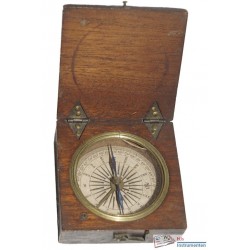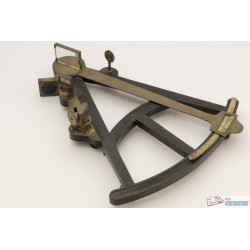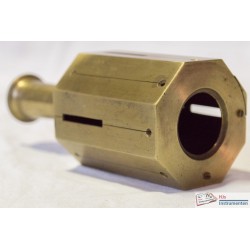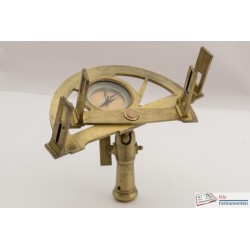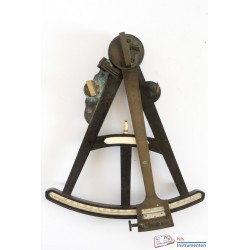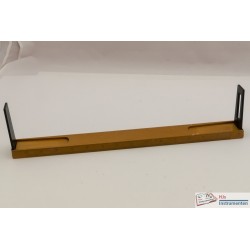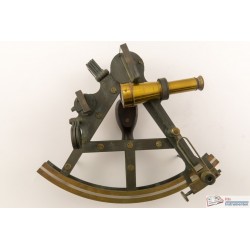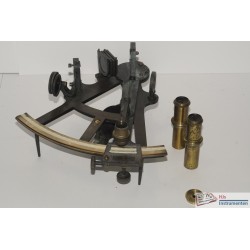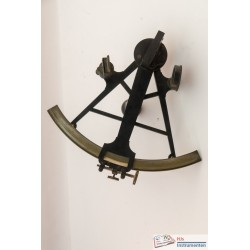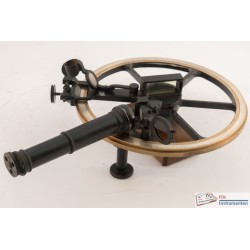Angle
Angular measurements are used in combination with distance measurements to create positions. Angular measurements are always based on a divided circle. The methods for dividing the circle differ. Where in mathematics a circle is 2pi radians, in navigation and hydrography the system of 360 degrees (further divided into minutes and seconds) is used. A sexagesimal (arc)minute is 1/60 of a degree, whereas a sexagesimal (arc)second equals 1/60 of an arcminute or 1/3600 of a degree. In landsurvey the (French) grad or gon system is used where the circle is divided into 400 gon. Each gon is then decimally divided into centigon or milligon. Finally in the various forces around the world the mil is used as a unit with a circle in NATO being defined as 6400 mil, making a mil close to a milliradian from which the abbreviation is derived.
In my collection there are various types of instruments used to measure angles:
- Compasses that measure the direction relative to Magnetic North or Geographic North (azimuth)
- Sextants that measure the angle between the observers point and two other objects that are brought into coincidence using a set of mirrors (reflecting devices)
- Theodolites that measure a horizontal and vertical direction towards an object relative to an arbitrary 'zero'. If the direction towards two objects is measured the angle between them can be computed.
- Clinometers that measure the angle relative to the horizontal ('level')
- Alhidades that are used to plot directions directly on a map
- Squares that allow a straight angle (90 degrees) to be set out
- Astronomic instruments that are not a sextant but still measure angles such as the astrolabe, quadrant and staff (Backstaff and Jakobstaff)
- Protractors that are used to measure and plot angles
Subcategories
-
Compasses
Most compasses in my collection use a magnetic needle to measure the direction of an object relative to magnetic North. As such they are disturbed by local magnetic deviations due to steel objects in the vicinity as well as the changing location of magnetic North relative to true North (variation). Some of the compasses can be adjusted for local variation.
A few compasses are of the gyroscopic or solar type and do not rely on the earth magnetic field. The gyrocompasses use a fast spinning mass (gyroscope) to indicate true North. The solar compass uses the movement of the sun and the fact that at 12:00 local (solar) time it points to South for obtaining directions.
-
Sextants
The sextant is an instrument to use a double reflection to measure the angle between two objects. Looking directly at the 'left' object the reference direction ('0') is obtained. Then moving the index mirror which is positioned on the index arm, the 'right' object is brought into coincidence with the left object in the horizon mirror. The angle between the two can then be read of the scale of the instrument.
I use the word sextant broadly as is done my most in the field. The sextant as a class can be subdivided into different types depending on the maximum angle that can be measured. Through the use of a double reflection, the angle measured is twice as large as the scale of the instrument; thus a sextant (1/6 of a circle or 60 degrees of scale) can measure up to 120 degrees.
- Octant measuring to 90 degrees
- Sextant measuring to 120 degrees
- Quintant measuring to 140 degrees
- Reflecting circle measuring above 140 degrees
As none of the sextants stop at an exact number, in my collection I use this classification a bit broader with an Octant any device measuring to around 110 degrees, the sextant up to 130 and te quintant up to 150 with anything more than 150 being a reflecting circle.
-
Theodolite
The theodolite is used for measuring directions, either horizontally or vertically. The vertical circle has a level attached to allow it to be set to zero when exactly level. The horizontal circle is set to zero at an arbitrary direction and from this zero all other directions are measured. Orginally the circles were made of metal but on most instruments in my collection the circles are made of glass and finely engraved.
Theodolites in my collection can be divided into:
- Optical theodolites using microscopes to read the circles
- Electronic theodolites (sometimes combined with a EDM to measure distances) where the circles are read digitally
- Boussole theodolite which uses a compass to determine local magnetic north and reference directions to that.
- Self reducing tachymeters that measure both the horizontal angle as well as the vertical angle and, together with a special staff, allow the direct reading of height differences and distances
-
Other angle
There are many instruments that measure an angle. Besides the main types in my collection (compasses, sextants and theodolites) I also have a number of other instruments that allow the measurement of angles. These are:
- Quadrant, or an instrument that uses gravity (a pendulum) to measure vertical angles along a 90 degree scale. Used in astronomy and land surveying
- Staff, used in astronomy (backstaff and jacobstaff) to measure either a vertical angle (in astronomy and navigation) or a horizontal angle (in landsurvey)
- Astrolabe. The astrolabes in my collection are all nautical astrolabes and were designed for use at sea or in land surveying. They indicate a vertical angle measured relative to gravity
- Alhidade or alidade is a set of visors connected to a ruler or similar used in the field to directly plot directions onto chart without having to transfer them from the instrument to the chart separately
- Square or optical square is an instrument to set out 90 degree angles (or 2 90 degree angles at once) using optics
- Clinometer is essentially a level that allows the measurement of vertical angles by using a rotating level

